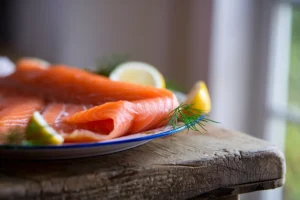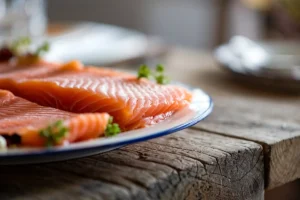Smoked salmon is a well-loved delicacy, enjoyed in various forms and cuisines around the world. It’s often found in brunch menus, gourmet dinners, and everything in between. However, a common question that arises when discussing this culinary delight is: Does smoked salmon taste better warm or cold? The answer is more nuanced than you might think.
The two primary types of smoked salmon — hot-smoked salmon and cold-smoked salmon — each offer distinct textures, flavors, and serving methods. Some people prefer the flaky, cooked texture of hot-smoked salmon, while others enjoy the smooth, delicate texture of cold-smoked salmon. This article will explore the differences between the two, how temperature affects flavor, the best ways to serve each, and ultimately answer the question: Is smoked salmon better served warm or cold?
What Is Smoked Salmon?
Smoked salmon is created by curing and smoking salmon fillets, typically using wood smoke as a preservation method. Smoking salmon has been a long-standing tradition in various cultures around the world, including those in Scandinavia, North America, and parts of Asia. The smoking process preserves the fish and enhances its flavor, imparting a distinctive smoky aroma and taste.
Types of Smoked Salmon: Hot-Smoked vs. Cold-Smoked
There are two main methods for smoking salmon: hot-smoking and cold-smoking. Both result in very different products, with distinct flavor profiles and textures.
- Hot-Smoked Salmon: In hot-smoking, the salmon is smoked at a higher temperature, typically between 120°F and 180°F. This process effectively cooks the fish, giving it a firm, flaky texture. Hot-smoked salmon is often used in salads, pastas, and served as a main dish.
- Cold-Smoked Salmon: On the other hand, cold-smoking occurs at much lower temperatures, usually between 68°F and 86°F. This method does not cook the fish but rather cures it. The result is a soft, silky texture with a mild, subtle smoke flavor. Cold-smoked salmon is typically served raw in dishes like bagels and lox, sushi, and canapés.
Key Differences Between Hot-Smoked and Cold-Smoked Salmon
Understanding the differences between hot-smoked and cold-smoked salmon is crucial for deciding whether it’s best served warm or cold. Both methods offer distinct characteristics in terms of texture, flavor, and preparation.
Temperature and Process
The most obvious difference between the two types of smoked salmon lies in the temperatures used during the smoking process:
- Hot-smoked salmon is smoked at high temperatures that cook the fish. This results in a firmer, flakier texture.
- Cold-smoked salmon, by contrast, is smoked at low temperatures, which do not cook the fish but instead cure it. This method preserves the fish’s raw-like texture, giving it a smooth and velvety feel.
Texture and Appearance
- Hot-Smoked Salmon: Due to the higher smoking temperature, hot-smoked salmon has a denser, flaky texture. It’s similar to cooked fish, making it a great option for those who prefer the taste of fully cooked salmon. It is also opaque, with a light pink to orange color.
- Cold-Smoked Salmon: In contrast, cold-smoked salmon has a much softer and more delicate texture. The fish appears translucent and has a more raw appearance, similar to sushi-grade salmon. It’s buttery and melts in your mouth, making it a favorite for people who enjoy the taste of raw or cured fish.
Flavor
- Hot-Smoked Salmon: The higher smoking temperature infuses the fish with a stronger, more robust smoky flavor. This type of smoked salmon pairs well with hearty dishes and is often served warm. It’s ideal for people who love a deep, savory flavor in their salmon.
- Cold-Smoked Salmon: Because it is not cooked, cold-smoked salmon has a milder, more delicate smoky flavor. It’s perfect for light dishes where the subtle taste of the fish can shine through without being overpowered by strong seasonings or cooking methods.
Serving Methods
- Hot-Smoked Salmon: You can serve hot-smoked salmon warm or cold. When served warm, the smoky flavor becomes more pronounced, and the texture becomes even flakier. It’s a popular choice for warm salads, pasta dishes, and breakfast meals like smoked salmon frittatas or scrambled eggs.
- Cold-Smoked Salmon: Cold-smoked salmon is almost always served cold. It’s frequently used in dishes where its delicate texture can be appreciated, such as bagels with cream cheese, smoked salmon canapés, and sushi. It’s also commonly served on charcuterie boards with crackers, cheese, and fresh vegetables.
Does Temperature Affect the Taste of Smoked Salmon?
The temperature at which you eat smoked salmon can significantly affect how it tastes. Whether you serve it warm or cold, the flavor and texture will change, and this may influence your overall enjoyment of the dish.
How Temperature Influences Flavor
- Hot-Smoked Salmon: When served warm, the oils in hot-smoked salmon become more pronounced, enriching the flavor and making it more savory. Warming hot-smoked salmon also enhances its smoky aroma, making the experience of eating it more intense. In contrast, if you serve it cold, the flavors become subtler, and the texture is more firm, almost like cooked chicken.
- Cold-Smoked Salmon: Since cold-smoked salmon isn’t cooked, it retains its silky texture and subtle flavors when eaten cold. Serving it warm can ruin its delicate texture and soften the fish too much, which diminishes its appeal. Cold-smoked salmon is best enjoyed chilled, as the cool temperature complements its raw-like, buttery qualities.
Best Temperature for Enjoying Smoked Salmon
- Hot-smoked salmon is typically best enjoyed warm, as the heat enhances its flavor and texture. The warmth brings out the richness of the fish and the depth of its smoky flavor.
- Cold-smoked salmon, on the other hand, is best served chilled. The cool temperature preserves its silky texture and allows the mild smoky flavor to remain subtle and refined.
Popular Dishes Featuring Smoked Salmon
Smoked salmon is incredibly versatile and can be used in a wide variety of dishes, whether served warm or cold. Below are some popular ways to enjoy both hot-smoked and cold-smoked salmon.
Dishes with Hot-Smoked Salmon
- Warm Smoked Salmon Salad: Toss hot-smoked salmon with fresh greens, roasted vegetables, and a lemon vinaigrette for a light but satisfying meal.
- Smoked Salmon and Pasta: Add chunks of hot-smoked salmon to creamy pasta dishes like fettuccine alfredo or smoked salmon carbonara. The warmth of the dish enhances the fish’s rich flavor.
- Smoked Salmon Breakfast: Serve hot-smoked salmon with scrambled eggs, toast, or on a bagel with cream cheese. You can also incorporate it into a frittata or quiche.
Dishes with Cold-Smoked Salmon
- Bagels and Lox: This classic dish features cold-smoked salmon served on a toasted bagel with cream cheese, capers, red onion, and fresh dill.
- Smoked Salmon Canapés: Perfect for entertaining, these bite-sized appetizers feature cold-smoked salmon served on crackers or small slices of bread with cream cheese, herbs, and sometimes a squeeze of lemon.
- Sushi and Sashimi: Use cold-smoked salmon in sushi rolls or serve it sashimi-style with soy sauce, wasabi, and pickled ginger.
Health and Nutritional Benefits of Smoked Salmon
Smoked salmon is not only delicious but also offers several nutritional benefits. Both hot-smoked and cold-smoked salmon are rich in protein, healthy fats, and essential nutrients. However, there are some slight differences in their nutritional profiles due to the smoking methods used.
Protein and Omega-3 Fatty Acids
Both hot-smoked and cold-smoked salmon are excellent sources of protein, making them a healthy addition to any diet. They also provide a significant amount of omega-3 fatty acids, which are essential for heart health, brain function, and reducing inflammation in the body.
Vitamins and Minerals
Smoked salmon is rich in important vitamins and minerals, including:
- Vitamin D: Vital for bone health and immune function.
- Vitamin B12: Important for maintaining nerve health and producing red blood cells.
- Selenium: An antioxidant that helps protect the body from oxidative stress.
Sodium Content
One thing to keep in mind when consuming smoked salmon is its sodium content. The curing process used in smoking salmon typically involves salt, which can result in higher sodium levels. This is especially true for cold-smoked salmon, which relies on the salt for preservation. For those on a low-sodium diet, it’s essential to monitor portion sizes.
FAQs About Smoked Salmon
Here are some of the most frequently asked questions regarding smoked salmon, its preparation, and how to serve it.
Can You Eat Cold-Smoked Salmon Warm?
While it’s technically possible to heat cold-smoked salmon, doing so can alter its delicate texture and mild flavor. If you prefer a firmer, cooked texture, it’s better to choose hot-smoked salmon, which is already cooked and better suited for warming.
Is Cold-Smoked Salmon Safe to Eat Without Cooking?
Yes, cold-smoked salmon is safe to eat without cooking. The smoking process cures the fish, and as long as it’s stored properly, there’s no need to cook it before eating.
What’s the Best Way to Reheat Smoked Salmon?
If you need to reheat hot-smoked salmon, do so gently to avoid drying it out. Use a low heat setting in the oven or reheat it in a pan with a small amount of butter or oil. Avoid reheating cold-smoked salmon, as it will lose its delicate texture and flavor.
Does Smoked Salmon Lose Flavor When Reheated?
Reheating smoked salmon can cause it to lose some of its smoky flavor, especially if it’s cold-smoked salmon. For the best taste, try to consume cold-smoked salmon cold, and only reheat hot-smoked salmon carefully.
How Should Smoked Salmon Be Stored?
Both hot-smoked and cold-smoked salmon should be stored in the refrigerator and consumed within a few days of opening. If you’re not planning to eat it right away, smoked salmon can be frozen for up to three months.
Conclusion: Does Smoked Salmon Taste Better Warm or Cold?
So, does smoked salmon taste better warm or cold? The answer depends on the type of smoked salmon you’re eating and your personal preference.
- Hot-smoked salmon is typically best served warm, as the heat enhances its smoky flavor and flaky texture. It pairs well with hearty dishes and is a great choice for warm meals.
- Cold-smoked salmon shines when served cold. Its delicate, buttery texture and subtle flavor make it ideal for lighter dishes like bagels, sushi, and appetizers.
Both types of smoked salmon have their own unique appeal, and the best way to decide which you prefer is to try them both. Whether you enjoy it warm or cold, smoked salmon offers endless possibilities for culinary creativity.



